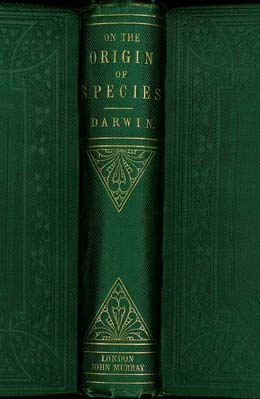Near the end of 1859, a year full of stabilizing events in the Pacific Northwest, Charles Darwin’s revolutionary book, On the Origin of Species, is released to the book trade in Great Britain. Although it will take some years for his ideas and books find their way to the Northwest, by the end of the nineteenth century Darwin’s explanation for the diversity of species will be accepted broadly by natural scientists in the Northwest. By 2009, the sesquicentennial of the publication of On the Origin of Species, there will be two copies of the first edition in Washington state libraries: one at the Spokane Public Library and another at Whitman College in Walla Walla.
On the Origin of On the Origin
The year 1859 was a stabilizing year for the Pacific Northwest: Oregon became the 33rd state; treaties with a number of native tribes were ratified; John Mullan began construction of a road linking the Columbia and Missouri rivers; the town of Walla Walla was named and platted; and Whitman Seminary (later College) was chartered by the Washington Territorial Legislature. In November of that same year, a very different sort of event occurred in London, England: Charles Darwin (1809-1882) published a book that challenged the established view of the origin of species.
After he had completed his university education, Darwin set off on a five-year, round-the-world survey on the H.M.S. Beagle as a companion to the captain and as a collector of natural specimens. Darwin’s observations during this voyage led him to question the then prevalent view of the fixity of species. He began to articulate a theory of natural selection in the 1840s, but he became involved in other work and did not return to focus on the subject until the mid-1850s.
In 1858, after two years of work on a book-length manuscript on natural selection, Darwin received a manuscript from Alfred Russel Wallace (1823-1913). This manuscript described a theory of evolution that was nearly identical to Darwin’s, which Wallace, who made a living by collecting and selling biological specimens for private cabinets of curiosities, had developed to account for the diversity of species that he had observed during his own travels.
Wallace’s manuscript was presented and published along with contributions from Darwin in the summer of 1858, and then Darwin set aside his own massive manuscript on natural selection and began working on an “abstract” of it. On October 1, 1859, Darwin noted in his pocket diary that it had taken him “13 months & 10 days” to complete this work. Since the finished product was not the book that he had imagined initially -- a large book with footnotes, a bibliography, and extensive tables -- Darwin wanted to call it “An Abstract.” The commercial publisher, John Murray, brought out the book with the title On the Origin of Species by Means of Natural Selection, or the Preservation of Favored Races in the Struggle for Life. Murray printed 1,250 copies of the book, all of which were purchased by wholesale subscribers on the first day of availability, November 22, a few days before the official publication date. In his diary, Darwin wrote:
During end of November & beginning of December employed in correcting for 2d. Edition of 3000 copies.
Multitude of Letters.
On the Origin of Species
quickly crossed the Atlantic. There were three pirate reprintings in New York City before July 1860, after which official American editions began to appear.
Northwest Naturalists
Darwin’s voyage on the Beagle, which brought him to the Pacific Ocean but no farther north than the Galapagos Islands, occurred about 30 years after the Lewis and Clark Expedition and preceded by a couple years the U.S. Exploring Expedition led by Charles Wilkes (1798-1877). The naturalists on these expeditions were not influenced by Darwin nor, apparently, were those who participated in the subsequent military, railroad, boundary, or marine surveys of the Northwest that were conducted in the following decades.
By the early 1870s, the physician Albert Chase Folsom (1847-1885), who helped found the Snohomish Athenaeum (the library of which included Darwin’s Descent of Man), and State Geologist of Oregon Thomas Condon (1822-1907) were familiar with and open to Darwin’s ideas. Amateur naturalists, such as those who organized the Young Naturalists’ Society in Seattle in 1879, also adopted ideas informed by Darwin’s theory of evolution. By the 1890s, the work of Northwest naturalists, which helped document the rich variety of fauna and flora in the region, was becoming connected with a professional community of biologists and natural history museum curators. By the semi-centennial of the publication of On the Origin of Species, Darwin’s ideas were being taught at Northwest colleges and universities and his books could be found in their libraries.
Washington’s Firsts
Although early editions of Darwin’s works may be found in many of the older public and academic libraries in the state, by the sesquicentennial of the publication of On the Origin of Species there were two known copies of the first edition in Washington libraries. By the 1930s, Spokane City Librarian George W. Fuller (1876-1940), who believed that public libraries should provide access to “permanent treasures of educational usefulness,” had obtained a copy of the first edition for the Spokane Public Library (Fuller, 2).
In 2004, a copy of the first edition was donated to Whitman College by an alumnus whose mother had purchased it for $100 at a New York auction house in 1950.

